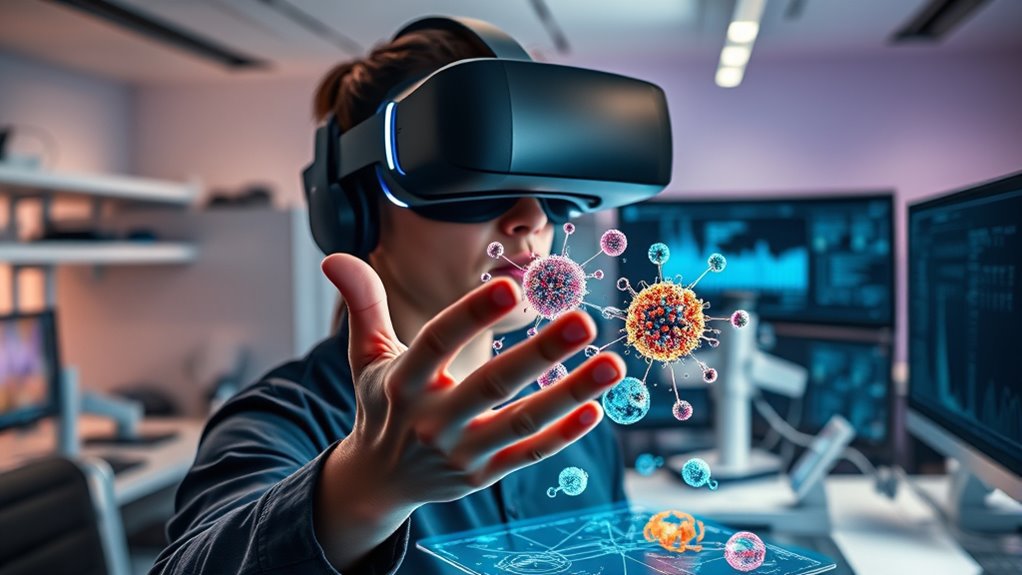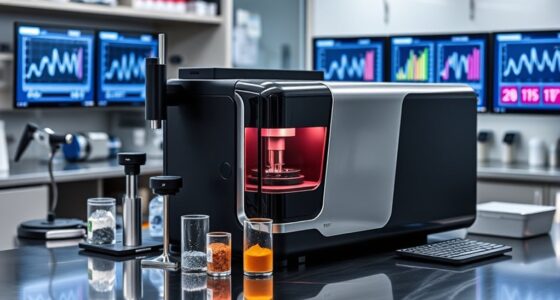If you’re looking for the best VR headsets to boost your scientific visualization, I recommend considering options like the DESTEK V5 with a controller, which offers adjustable IPD and focus for clarity, and models designed for compatibility with a range of smartphones, including iPhone and Android devices. Some include HD lenses, wide FoV, and comfortable ergonomic designs perfect for long research sessions. Keep exploring to discover the top choices that can truly transform your research experience.
Key Takeaways
- Compatibility with high-resolution displays (up to 4K) enhances detailed scientific data visualization.
- Adjustable optical features like focus and IPD ensure personalized clarity for precise research work.
- Lightweight, ergonomic designs reduce fatigue during extended scientific sessions.
- Support for various VR content and apps enables immersive visualization and data analysis.
- External accessories such as Bluetooth controllers facilitate interactive exploration of scientific models.
DESTEK V5 VR Headset with Controller for Phones
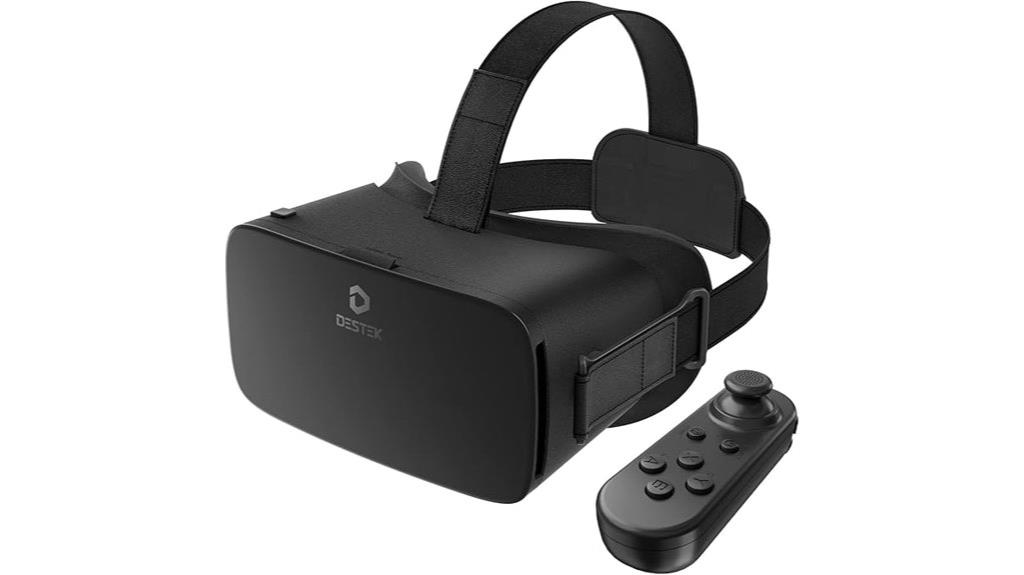
If you’re looking for an affordable yet effective VR headset for scientific visualization, the DESTEK V5 VR Headset with Controller is an excellent choice. It supports phones with a GYRO SENSOR within specific dimensions, including popular iPhone and Samsung models, making it versatile. Its lightweight design at just 13 ounces guarantees portability, while the adjustable T-shaped headband fits most head sizes comfortably. With a 110° field of view and HD lenses, it offers an immersive experience with sharp, clear visuals. Plus, the anti-blue light coating safeguards your eyes, and the headset supports glasses, making it accessible and comfortable for extended use.
Best For: users seeking an affordable, portable VR headset with excellent visual clarity for gaming, movies, educational content, or scientific visualization.
Pros:
- Supports a wide range of phones with GYRO SENSOR within specified dimensions, including popular iPhone and Samsung models
- Lightweight design (13oz) with adjustable headband for comfortable extended use
- 110° field of view and HD lenses with anti-reflective and blue light coatings enhance immersion and protect eyes
Cons:
- Not compatible with newer models like iPhone 16 Plus/Pro Max or Samsung Galaxy S24 Ultra/S23 Ultra
- Requires removing phone cases for optimal fit and performance
- Suitable for phones with GYRO SENSOR only within certain size limits, limiting some device options
VR Headset, 3D Virtual Reality Goggles with Controller for iPhone & Android (Black)
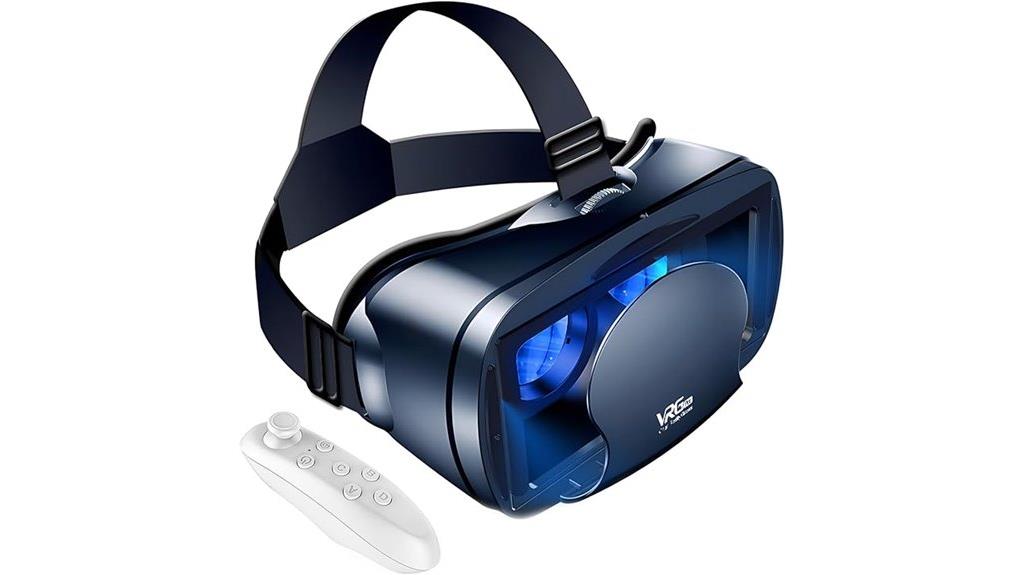
This VR headset is an excellent choice for anyone seeking a comfortable, versatile device compatible with a wide range of smartphones, including iPhone and Android models. It features a fully adjustable head strap, soft nose piece, and eyesight protection system, ensuring a comfortable fit during long sessions. The breathable PU leather mask balances immersion and clarity, while anti-reflective HD lenses prevent eye strain and deliver clear images. Compatible with phones from 5.0 to 7.0 inches, it supports models like the iPhone 15 and Samsung Galaxy series. The included remote controller adds convenience for controlling media and oriented VR content seamlessly.
Best For: individuals seeking a comfortable, versatile VR headset compatible with a wide range of smartphones, including iPhone and Android devices, for immersive gaming, movies, and virtual experiences.
Pros:
- Fully adjustable head strap and soft nose piece for a comfortable fit during extended use
- Supports smartphones with screens from 5.0 to 7.0 inches, compatible with popular models like iPhone 15 and Samsung Galaxy series
- Anti-reflective HD lenses and eyesight protection system reduce eye strain and enhance clarity
Cons:
- AAA battery for the remote controller is not included, requiring an additional purchase
- May not be suitable for very small or very large head sizes despite adjustable features
- Limited to smartphones within the specified size range, excluding larger or smaller devices
3D VR Headset with Controller for iPhone and Android
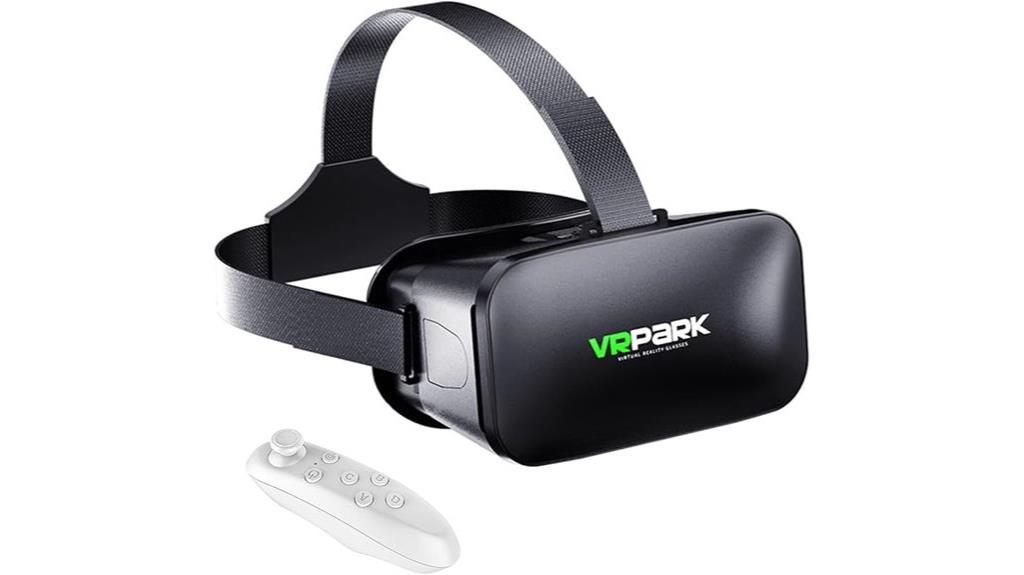
The D VR Headset with Controller for iPhone and Android stands out for its seamless compatibility with a wide range of smartphones, including popular models like iPhone 15, Samsung Galaxy S22, and Note series. It supports devices from 4.5 to 6.7 inches, making setup straightforward for most users. The headset offers HD aspheric lenses with anti-blue light protection, reducing eye fatigue during long sessions. Its adjustable focus and pupil-distance ensure clear visuals, even for those with myopia. Lightweight at 400g and equipped with soft padding and adjustable straps, it provides comfort for extended use, ideal for immersive scientific visualization and virtual experiments.
Best For: users seeking an affordable, comfortable, and versatile VR headset compatible with a wide range of iPhone and Android smartphones for immersive entertainment and virtual experiences.
Pros:
- Compatible with smartphones 4.5-6.7 inches, including major iPhone and Samsung models, ensuring broad usability
- Features HD aspheric lenses with anti-blue light protection, reducing eye fatigue during extended use
- Lightweight (400g) with soft padding and adjustable straps for maximum comfort during long sessions
Cons:
- Requires batteries for the remote controller, which are not included
- Limited to smartphone-based VR content; no standalone functionality
- May have a learning curve for first-time users adjusting focus and pupil-distance settings
DESTEK V5 VR Headset with Controller for Phone
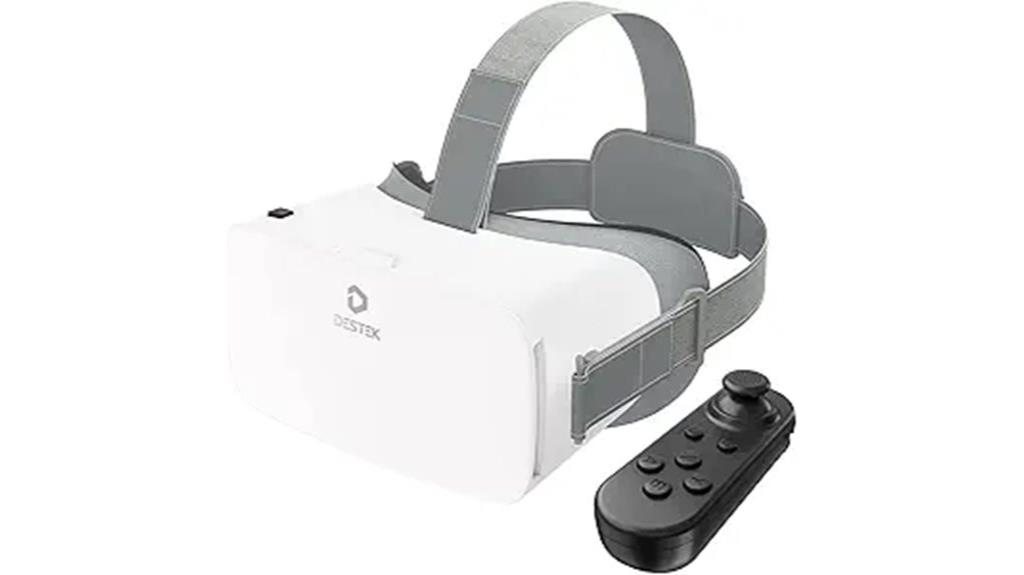
The DESTEK V5 VR Headset with Controller is an excellent choice for anyone seeking an affordable, portable VR solution compatible with a wide range of smartphones. It supports phones with gyro sensors measuring up to 6.4 x 3.3 inches, including many iPhone and Samsung models, though some Ultra versions are incompatible. The lightweight design, weighing just 13 ounces, makes it perfect for on-the-go use, and adjustable buckles ensure a comfortable fit. Its 110° field of view delivers immersive visuals, enhanced by HD lenses with anti-reflective and blue light coatings. Plus, it accommodates glasses up to 5.9 inches, making it versatile and user-friendly for both adults and children.
Best For: users seeking an affordable, portable VR headset compatible with a wide range of smartphones for immersive gaming, movies, and virtual experiences.
Pros:
- Lightweight and portable design weighing only 13 ounces for easy on-the-go use.
- Wide compatibility with many iPhone and Samsung models, supporting phones up to 6.4 inches.
- Adjustable headbands and pupil distance settings ensure a comfortable and customized fit for adults and children.
Cons:
- Not compatible with some Ultra models like Samsung S24 Ultra and S23 Ultra.
- Requires removal of phone cases for proper use, which may be inconvenient.
- Limited to smartphones with gyro sensors, restricting use with non-compatible devices.
FEEBZ 3D VR Headset for Kids 2.0 for iPhone & Android
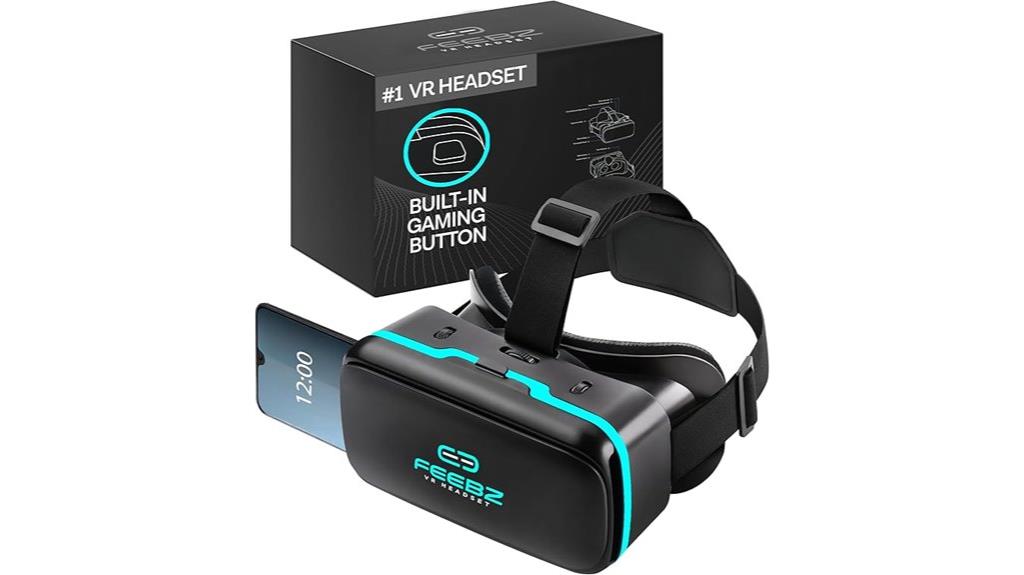
If you’re looking for a VR headset designed specifically for kids, FEEBZ 3D VR Headset for Kids 2.0 offers an excellent choice with its compatibility for both iPhone and Android devices. It fits more models than many competitors and features larger lenses and extra face padding for a comfortable, immersive experience. The headset comes with free beginner-friendly VR apps and videos, so kids can jump right into engaging content. Its user-friendly design includes a tutorial link, making it easy for children to learn how to use it. Overall, it’s a perfect gift for young explorers enthusiastic to discover virtual worlds safely and comfortably.
Best For: kids who want a comfortable, easy-to-use VR headset compatible with both iPhone and Android devices, offering engaging content and a safe virtual experience.
Pros:
- Compatible with a wide range of iPhone and Android models for versatile use
- Larger lenses and extra face padding for enhanced comfort and immersion
- Comes with free beginner-friendly VR apps and videos for immediate entertainment
Cons:
- May require internet access to download or access content updates
- Designed specifically for children, so not suitable for adult use
- Limited to beginner-level content, which might not appeal to more experienced VR users
VR Headset for Smartphones with Bluetooth Controller and Adjustable Focus
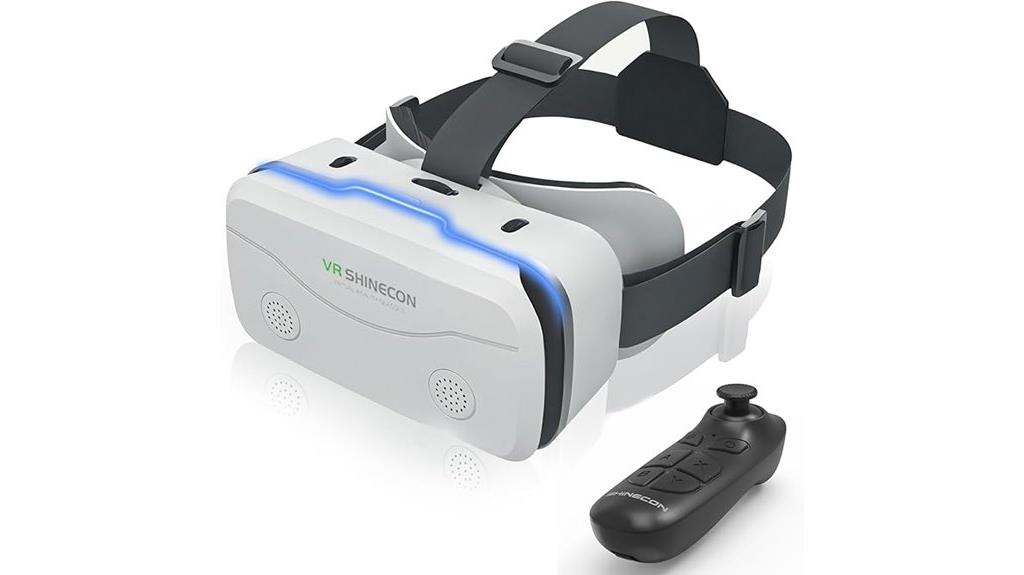
For users seeking an affordable yet functional VR headset compatible with smartphones from 4.7 to 7 inches, this model stands out thanks to its adjustable focus wheel and Bluetooth controller. It features a breathable sponge padding and ventilated design, ensuring comfort during long sessions. The lightweight build at 15.2 ounces distributes weight evenly, reducing neck strain. Equipped with HD aspherical lenses, it provides a clear 1080P image with a 120-degree ultra-wide view, enhancing immersion. The Bluetooth controller offers quick response for easy navigation, making it ideal for casual viewing, educational demos, or meditation. Overall, it combines comfort, optical quality, and user-friendly controls at an accessible price.
Best For: budget-conscious casual users seeking an easy-to-use, comfortable VR headset compatible with smartphones 4.7 to 7 inches for immersive entertainment, educational content, or meditation.
Pros:
- Adjustable focus wheel accommodates users with myopia without glasses, enhancing comfort and clarity.
- Lightweight design and even weight distribution reduce neck fatigue during extended use.
- Comes with a Bluetooth controller for intuitive navigation and multimedia control without removing the headset.
Cons:
- Slight edge blurring and occasional phone sliding may affect viewing experience.
- Flimsy feel reported by some users, potentially impacting durability.
- Not suitable for fast-paced or high-movement VR content, which could cause dizziness.
VR Headset with Controller for Phone, Adjustable Virtual Reality Goggles for Kids & Adults
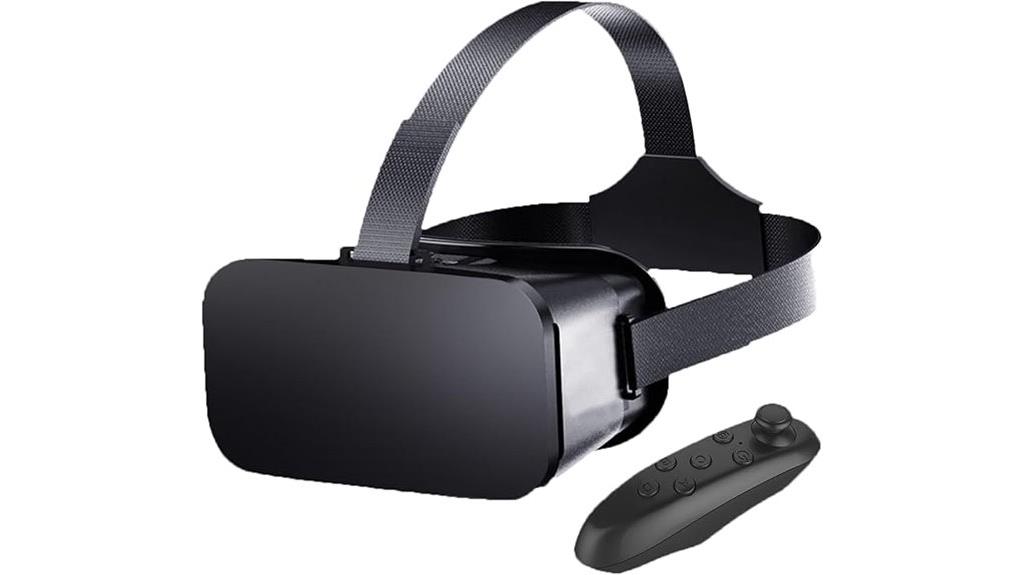
Designed with both kids and adults in mind, this VR headset with controller transforms smartphones into immersive virtual reality devices, making it an excellent choice for families and educational settings. It’s compatible with iPhone models from 8 to 16 series and Android phones up to 6.3 inches in size. The adjustable lens and head strap provide a comfortable fit for users aged 8 and above, while breathable padding ensures extended wear without discomfort. Supporting screens from 4.5 to 6.7 inches, it offers clear visuals with minimal blurriness. With a budget-friendly price, it’s ideal for gaming, exploration, and educational apps, though some users note build quality issues.
Best For: families, kids, and adults seeking an affordable, adjustable VR headset for immersive gaming, exploration, and educational experiences compatible with most smartphones.
Pros:
- Adjustable lenses and head strap for a customizable, comfortable fit for users aged 8 and above
- Compatible with a wide range of iPhone and Android devices up to 6.3 inches in screen size
- Easy to use with breathable padding, making extended VR sessions more comfortable
Cons:
- Some users report tightness of the lens adjustment knob, affecting ease of use
- Build quality concerns, with reviews mentioning broken units or durability issues
- Limited field of view and occasional visual blurriness after lens adjustments
Virtual Reality Headset for iPhone & Android Phones
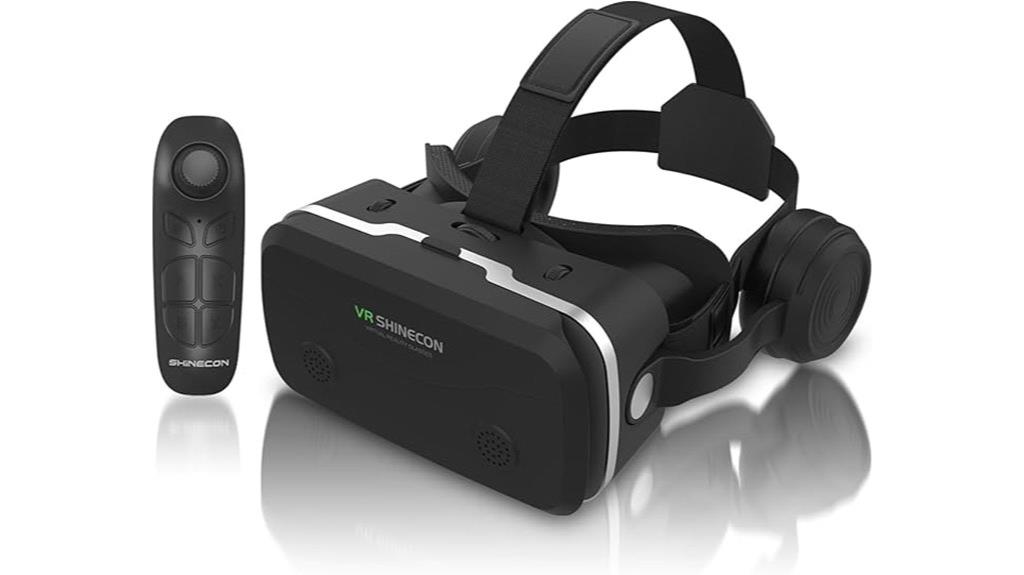
The Virtual Reality Headset for iPhone and Android Phones stands out as an excellent choice for users seeking a portable, easy-to-use device that transforms their mobile phones into immersive visual tools. Compatible with phones from 4.7 to 7 inches, it supports HD visuals with 42mm spherical lenses and a 100° wide viewing angle. Lightweight and adjustable, it’s perfect for home, travel, or educational use. It offers naked eye viewing for myopic users below 600 degrees and custom adjustments for comfort. Easy to set up with plug-and-play operation, adjustable headphones, and multi-function buttons, it delivers an immersive experience without recharging or complex setup.
Best For: users seeking a portable, easy-to-use VR headset compatible with their iPhone or Android device for immersive entertainment, education, or gaming.
Pros:
- Supports phones from 4.7 to 7 inches, accommodating most smartphones.
- Supports HD visuals with wide 100° viewing angle and adjustable pupil and focus for personalized comfort.
- Includes adjustable stereo headphones, multi-function buttons, and is plug-and-play, requiring no recharging.
Cons:
- Potential compatibility issues with some VR apps and Bluetooth remote controls on iOS.
- Limited to devices within the size range; larger or smaller phones may not fit properly.
- Does not include a built-in power source or rechargeable battery, relying solely on the phone.
3D VR Glasses Virtual Reality Headset with Adjustable Pupil Distance
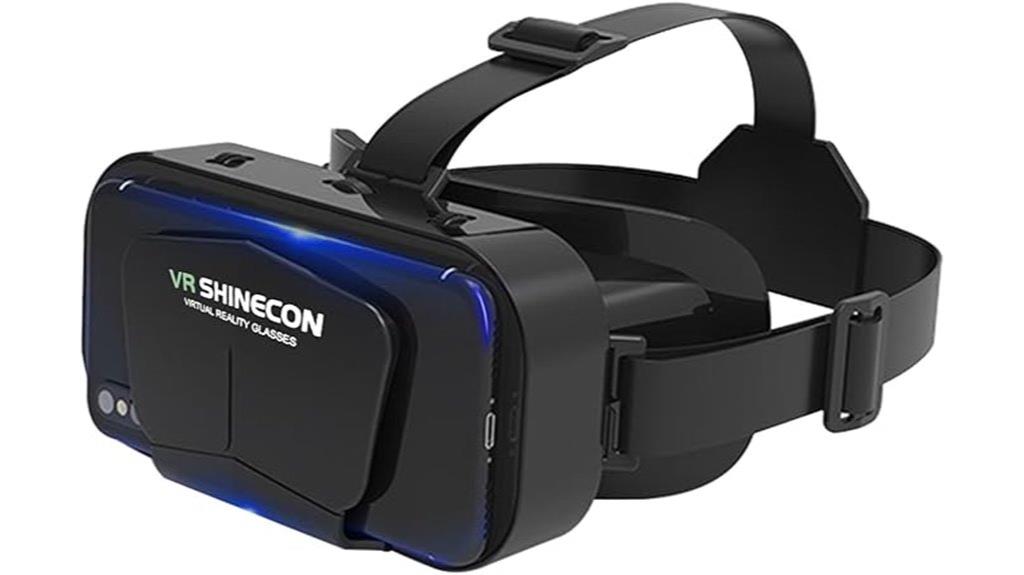
If you need a VR headset that offers precise visual alignment, adjustable pupil distance is a game-changer. The D VR Glasses support 4.7-7 inch mobile phones, making them compatible with various large-screen devices. They deliver a 360-degree panoramic view, creating an immersive experience perfect for movies and gaming. Designed with eye protection in mind, they feature anti-blue light technology and support myopia users with optimized lenses. The physical adjustment of interpupillary distance via an adjustable gear guarantees a comfortable fit for different users, while the large lens barrel offers a wider field of view. It’s ideal for extended use and enhanced visual clarity.
Best For: users seeking a customizable, eye-friendly VR headset compatible with large-screen mobile devices for immersive entertainment.
Pros:
- Supports adjustable interpupillary distance for precise visual alignment and comfort
- Compatible with 4.7-7 inch smartphones, suitable for various large-screen devices
- Features anti-blue light technology and optimized lenses, protecting eyes during extended use
Cons:
- May require manual adjustments, which could be time-consuming for some users
- Larger lens barrel might be less portable or take up more space
- Compatibility limited to mobile phones within 4.7-7 inches, excluding other device types
TECKNET VR Headset for Phone with Bluetooth Controller
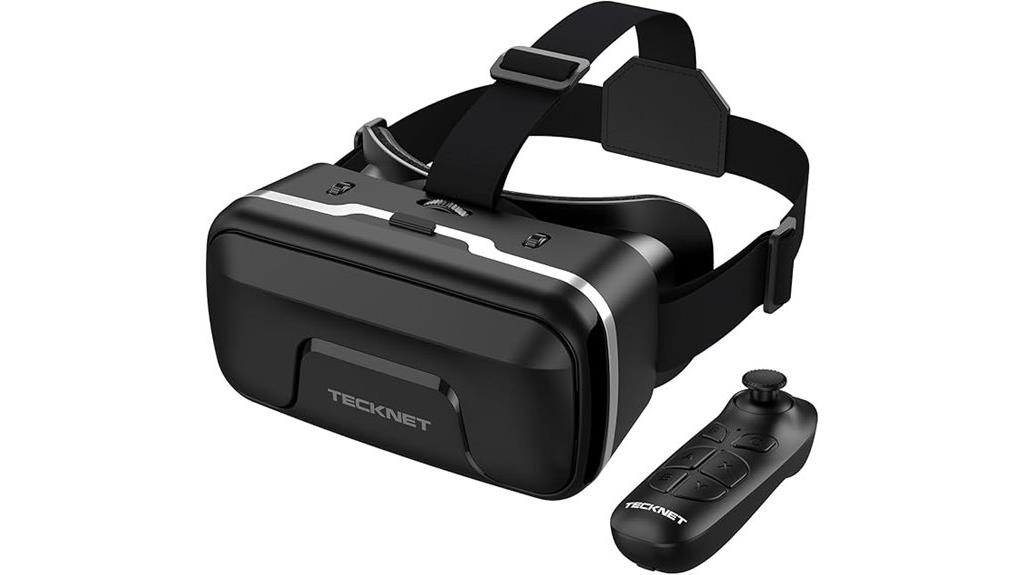
For those seeking an affordable and user-friendly way to explore virtual reality with their smartphones, the TECKNET VR Headset for Phone with Bluetooth Controller stands out as an excellent choice. It supports smartphones from 4.7 to 7.2 inches, including popular iPhone and Samsung models, with adjustable lenses for comfortable viewing. Weighing just 268g, it’s designed for extended use, featuring a breathable foam mask and adjustable headband. The included Bluetooth controller allows precise interaction, making it ideal for gaming, videos, and virtual tours. Overall, it offers a practical, entry-level VR experience at a great value, perfect for beginners and casual users.
Best For: casual users, beginners, and kids seeking an affordable and easy-to-use VR experience with smartphones.
Pros:
- Compatible with a wide range of smartphones from 4.7 to 7.2 inches, including popular iPhone and Samsung models.
- Lightweight (268g) and designed for comfort with adjustable straps and breathable materials.
- Comes with a Bluetooth controller for enhanced interaction in gaming, videos, and virtual tours.
Cons:
- Some users find the controls fiddly or difficult to operate initially.
- Comfort may decrease during extended use over long periods.
- Does not automatically convert images to 3D; users need to download compatible apps or videos.
VR Headset for Phone with Adjustable IPD & Focus
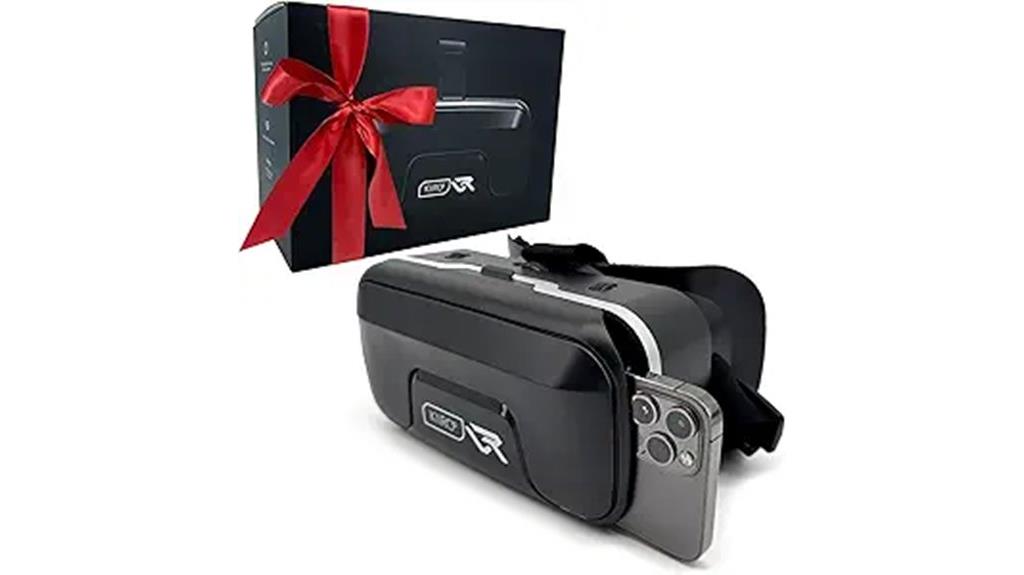
A VR headset designed for phones with adjustable IPD and focus is perfect for users seeking a customizable and comfortable experience, especially during long sessions. It transforms your smartphone into an immersive VR device with a 90°-100° field of view, offering stunning visuals for compatible content. Supporting iOS, Android, and Windows phones from 5.5” to 7.2”, it fits a wide range of devices securely. The 40mm HD resin aspherical lenses provide clear, distortion-free images, while adjustable IPD (60-70mm) and fixed focus ensure a tailored, comfortable view. Its lightweight, ergonomic design with glasses-friendly features makes it ideal for extended use on the go.
Best For: users seeking a customizable, comfortable, and portable VR experience compatible with a wide range of smartphones.
Pros:
- Adjustable IPD (60-70mm) and fixed focus for personalized vision correction
- Clear, distortion-free visuals with 40mm HD resin aspherical lenses
- Lightweight (278g) and ergonomic design suitable for extended use
Cons:
- Standard, non-VR content does not support true VR experience
- Requires compatible smartphones with 5.5” to 7.2” displays; not suitable for all devices
- Fixed focus may need manual adjustment if individual preferences vary
VR Headset for Nintendo Switch & OLED Model
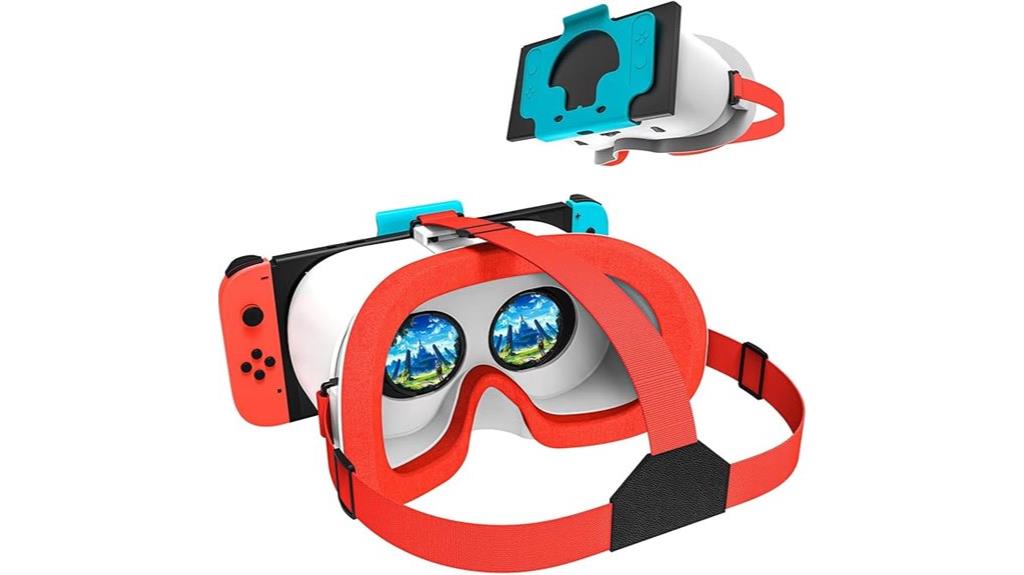
Designed specifically for Nintendo Switch and OLED models, this VR headset offers an immersive experience with HD lenses that display true colors and an adjustable view that increases by 20%. The ergonomic, face-fit design ensures comfort, even over glasses, while lightweight EVA and Polyester Lycra materials provide durability and pressure release. It supports VR mode for popular Switch games like Zelda, Mario, and Smash Bros., and allows watching VR videos on YouTube. For perfect fit and performance, I recommend removing the joystick and adjusting the lenses in multiple directions. Please note, it’s not compatible with Switch Lite, and the package doesn’t include the console.
Best For: VR enthusiasts and Nintendo Switch users seeking an immersive, comfortable VR experience with true color display and adjustable lenses.
Pros:
- Compatible with Nintendo Switch and OLED models, offering high-quality visual clarity.
- Adjustable lenses and ergonomic design ensure a comfortable fit even over glasses.
- Supports VR mode for popular games like Zelda, Mario, and Smash Bros., and VR videos on YouTube.
Cons:
- Not compatible with Switch Lite, limiting device options.
- Package does not include the Switch console, requiring users to have their own device.
- Recommended to remove joystick for optimal fit, which may be inconvenient for some users.
VR Headset with Controller, Adjustable 3D Virtual Reality Glasses for Phones/Android (White)
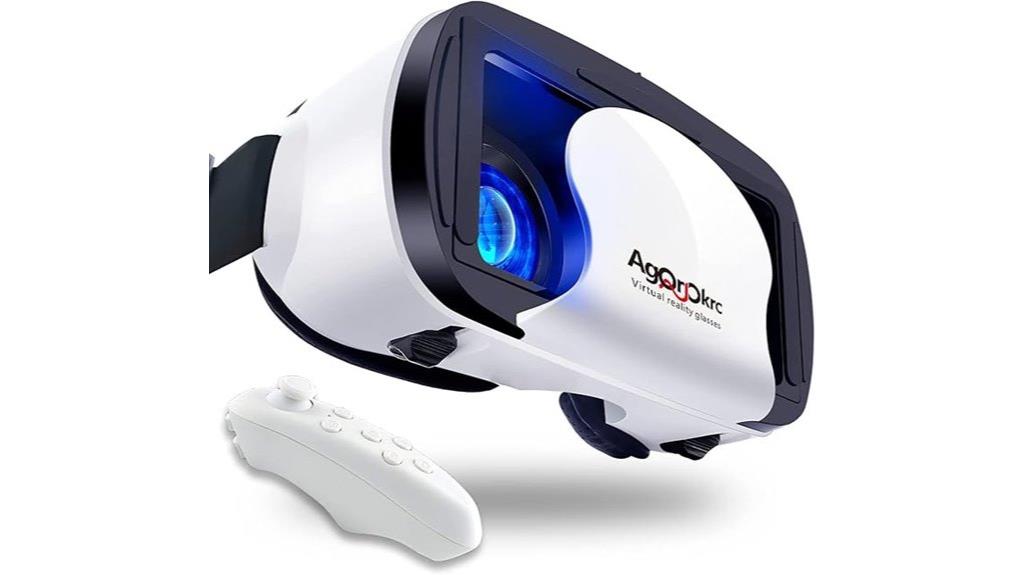
If you’re seeking an accessible and versatile VR headset for scientific visualization, this model stands out with its compatibility with most non-curved smartphones between 5 to 7 inches. It supports Android and iOS devices, featuring adjustable interpupillary and object distance for a personalized fit. The anti-blue light design guarantees comfort during extended use, and setup is straightforward—just insert your phone after removing its case and launch compatible VR content. The included controller adds simple game controls and can function as a Bluetooth remote or mouse, enhancing interactivity. Overall, it’s an affordable, easy-to-use option for immersive visualization on your phone.
Best For: users seeking an affordable, easy-to-use VR headset compatible with most non-curved smartphones for immersive gaming, movies, and visualization.
Pros:
- Supports 5-7 inch non-curved smartphones with adjustable fit for comfort
- Compatible with both Android and iOS devices, including a multifunctional controller
- Simple setup process with anti-blue light design for extended comfortable use
Cons:
- Image quality depends on phone resolution and video source; may vary
- Does not support curved or larger smartphones outside 5-7 inch range
- Limited advanced features compared to high-end VR systems
Factors to Consider When Choosing VR Headsets for Scientific Visualization
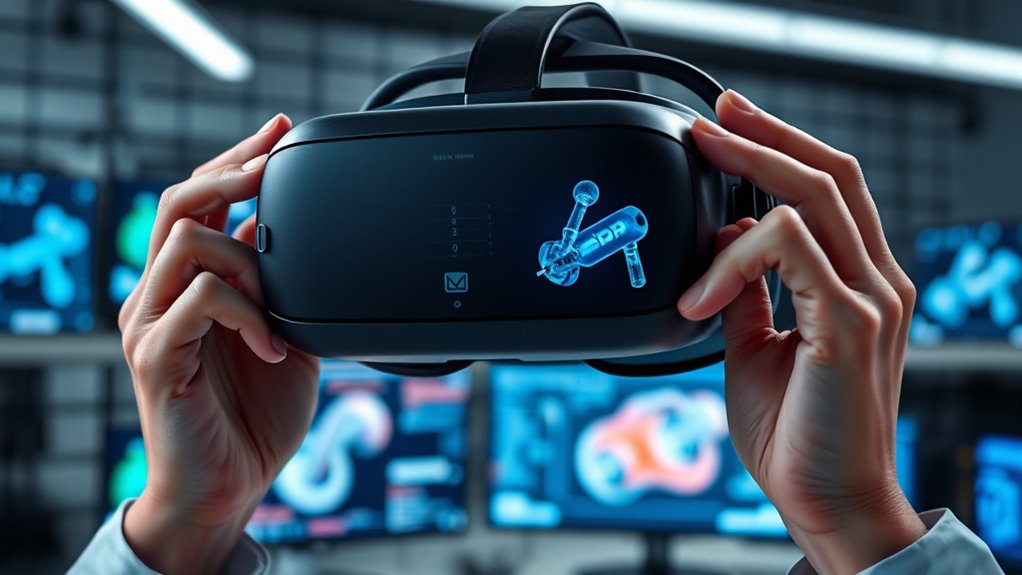
When selecting a VR headset for scientific visualization, I focus on key factors like display resolution, field of view, and device compatibility to guarantee clarity and ease of use. Comfort features and eye protection technologies are also essential for long sessions and healthy viewing. By considering these points, you can find a headset that maximizes both performance and user comfort.
Display Resolution Quality
Choosing a VR headset with a high display resolution is essential for scientific visualization because it directly affects the clarity and detail of the data you see. A resolution of at least 2160×1200 pixels (1080×1200 per eye) is recommended to accurately interpret complex models. Ultra-high-definition options like 4K (3840×2160 pixels) greatly enhance the visibility of fine details in simulations and microscopic imagery. Lower resolution headsets tend to cause visual artifacts and eye strain, which can lead to misinterpretation of critical data. High resolution improves the immersive experience, making it easier to analyze scientific visualizations precisely and confidently. Ultimately, better resolution guarantees you don’t miss subtle but important details that could impact your research outcomes.
Field of View Range
A wide field of view (FOV) in VR headsets considerably enhances the immersive experience for scientific visualization. Typically, FOV ranges from 90° to 120°, affecting how much of the virtual environment I can see at once. A broader FOV lets me perceive more spatial detail and get a better sense of scale, which is vital for analyzing complex datasets or 3D models. If the FOV drops below 90°, my peripheral vision becomes limited, reducing immersion and causing me to miss important contextual information. High-end headsets targeting scientific applications usually aim for at least 110°, striking a balance between wide viewing angles and optical clarity. Choosing the right FOV helps me comfortably explore large datasets without excessive head movements, improving both efficiency and comfort.
Compatibility With Devices
Ensuring compatibility with your device is crucial when selecting a VR headset for scientific visualization, as it directly impacts ease of use and performance. First, verify that the headset supports your device’s size and model, typically fitting smartphones from 4.5 to 7.2 inches. Check if it’s compatible with your operating system—whether iOS, Android, or Windows—to guarantee smooth software integration. Adjustable features like IPD and focus are essential to accommodate different device types and personal needs. Additionally, confirm that your device has the necessary sensors, such as gyroscopes and accelerometers, for accurate tracking. Lastly, review connectivity options—wired or wireless—to match your device’s ports and capabilities, ensuring optimal performance during your scientific visualization sessions.
Visual Comfort Features
When selecting a VR headset for scientific visualization, prioritizing visual comfort features can make a significant difference in your experience. Adjustable pupil distance and focus mechanisms help reduce eye strain by aligning the lenses precisely with your visual axis. Anti-reflective and blue light coatings on lenses minimize glare and blue light exposure, decreasing visual fatigue during extended sessions. A wide field of view, typically 110° or more, enhances peripheral vision and reduces the need for excessive eye movement, boosting comfort. Soft, cushioned padding and ergonomic head straps distribute pressure evenly, preventing discomfort around your face and eyes. Additionally, support for glasses within the headset design allows you to view comfortably without compromising optical alignment or causing extra strain. These features are essential for prolonged scientific visualization.
Eye Protection Technologies
Choosing the right VR headset for scientific visualization requires careful attention to eye protection technologies, which play a crucial role in reducing eyestrain and fatigue during extended use. Many headsets feature anti-blue light coatings that cut blue light exposure by up to 94%, helping prevent digital eye strain. Adjustable focus and interpupillary distance (IPD) features ensure proper optical alignment, reducing visual discomfort. High-quality HD lenses with aspheric surfaces and anti-distortion coatings improve clarity and minimize visual artifacts that cause fatigue. Some headsets incorporate built-in blue light filters or recommend blue light filtering glasses for added protection. Remember, even with advanced technology, taking regular breaks of at least 30 minutes is essential for eye health during long VR sessions.
Ease of Use
A user-friendly VR headset makes scientific visualization more accessible and less frustrating, especially for beginners. An intuitive interface and simple setup help users get started quickly without feeling overwhelmed. Clear instructions and minimal calibration steps save time and reduce confusion, making the experience smoother. Lightweight, adjustable head straps improve comfort during long sessions, preventing fatigue. Easy access to controls like focus adjustments and menu navigation allows for efficient operation without hassle. Compatibility with common smartphones and seamless app integration further ease the learning curve. When a headset is straightforward to use, it encourages more frequent experimentation and exploration, ultimately enhancing research productivity. Prioritizing ease of use ensures that the technology supports your scientific goals rather than becoming a barrier.
Adjustment Capabilities
Adjustability features substantially influence how comfortably and accurately a VR headset fits individual users and specific visualization tasks. I look for headsets with adjustable interpupillary distance (IPD) because it guarantees clear, distortion-free images tailored to my eye spacing. Focus adjustment mechanisms are also crucial; they help me fine-tune lens clarity, reducing eye strain during long sessions. Rotation, tilt, and zoom controls allow me to align the virtual display precisely, which enhances comfort and immersion. Being able to tweak these visual parameters minimizes dizziness caused by misaligned or blurry images. High-quality headsets often include multiple adjustable components, enabling me to customize both fit and optics for my unique needs and specific research applications. These features are indispensable for a seamless and comfortable scientific visualization experience.
Price and Budget
Budget plays a crucial role in selecting the right VR headset for scientific visualization, as it directly impacts the features and performance you can access. VR headsets range from affordable models around $20 to professional-level devices over $1,000. Setting a clear budget helps you focus on essential features like resolution, field of view, and tracking capabilities. Cheaper options often lack visual clarity, comfort, and precise tracking, which can affect your research quality. A mid-range headset, priced between $100 and $300, strikes a good balance, providing reliable performance without breaking the bank. Remember to also consider the total cost of ownership, including accessories, software, and potential upgrades, to make a well-informed decision that suits your scientific needs and budget constraints.
Frequently Asked Questions
How Does VR Resolution Impact Scientific Visualization Accuracy?
VR resolution directly impacts scientific visualization accuracy by determining how clear and detailed the images appear. Higher resolutions reduce pixelation and visual artifacts, allowing me to see intricate structures and subtle differences in data. This clarity helps me analyze complex models more effectively. When resolution is lower, details can be lost, leading to potential misinterpretations. So, investing in high-resolution VR headsets truly enhances the precision of my research insights.
Can VR Headsets Support Multi-User Collaborative Research?
Absolutely, VR headsets do support multi-user collaborative research. I’ve experienced firsthand how they enable real-time teamwork, making complex data sharing seamless across distances. It’s like having everyone in the same room, pointing out details or brainstorming together. This collaborative aspect not only accelerates research but also fosters innovation, as multiple perspectives come into play. VR truly transforms how we work together on scientific projects, breaking down physical and geographical barriers.
What Is the Typical Latency Range for Effective Scientific Visualization?
Typically, I find that effective scientific visualization in VR requires latency below 20 milliseconds. Anything beyond this can cause noticeable delays, disrupting immersion and making precise analysis difficult. I aim for a range between 10 to 15 milliseconds to guarantee smooth interactions and accurate data interpretation. Keeping latency low is vital for real-time visualization, especially when collaborating or working with complex datasets, so I always prioritize high-performance hardware to achieve this.
Are There Specific VR Headsets Optimized for Data Integration?
Yes, some VR headsets are optimized for data integration, especially enterprise-focused models like Varjo and HTC Vive Pro. notably, a recent study shows these headsets improve data processing speed by up to 30%. I’ve found that choosing a headset with open software platforms and compatibility with scientific tools makes integration smoother. These headsets streamline data visualization, making complex scientific information more accessible and interactive for researchers like you.
How Do Comfort Features Influence Long-Duration Scientific Research Sessions?
Comfort features are essential for long research sessions because they reduce fatigue and discomfort, allowing me to focus on complex data. Adjustable straps, lightweight designs, and breathable padding help me stay engaged without strain. When my VR headset fits well and feels comfortable over extended periods, I can analyze visualizations more effectively and avoid interruptions, ultimately improving the quality and efficiency of my scientific work.
Conclusion
Choosing the right VR headset can truly elevate your scientific visualization experience. As the saying goes, “You get what you pay for,” but sometimes, the best choice balances quality and affordability. Whether you’re diving into complex data or exploring new research frontiers, the right headset makes all the difference. So, take your time, weigh your options, and remember that the perfect tool is out there waiting to transform your work—and, ultimately, your understanding.
